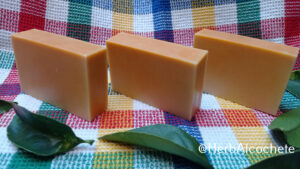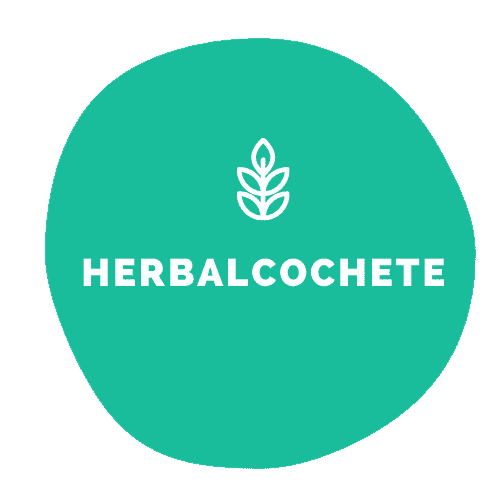This time, I come to you with another soap recipe that uses a natural colorant: tomato!
Learn how to make this tomato soap recipe, using tomato puree as a natural colorant. Follow a simple cold process soap recipe with natural ingredients like olive oil, coconut oil, and a wonderful fragrance with lavender and ylang-ylang. It’s a unique natural soap with a vibrant orange hue.
Be aware that using tomato puree instead of water in the lye water takes some special precautions. Read everything about it in this post.
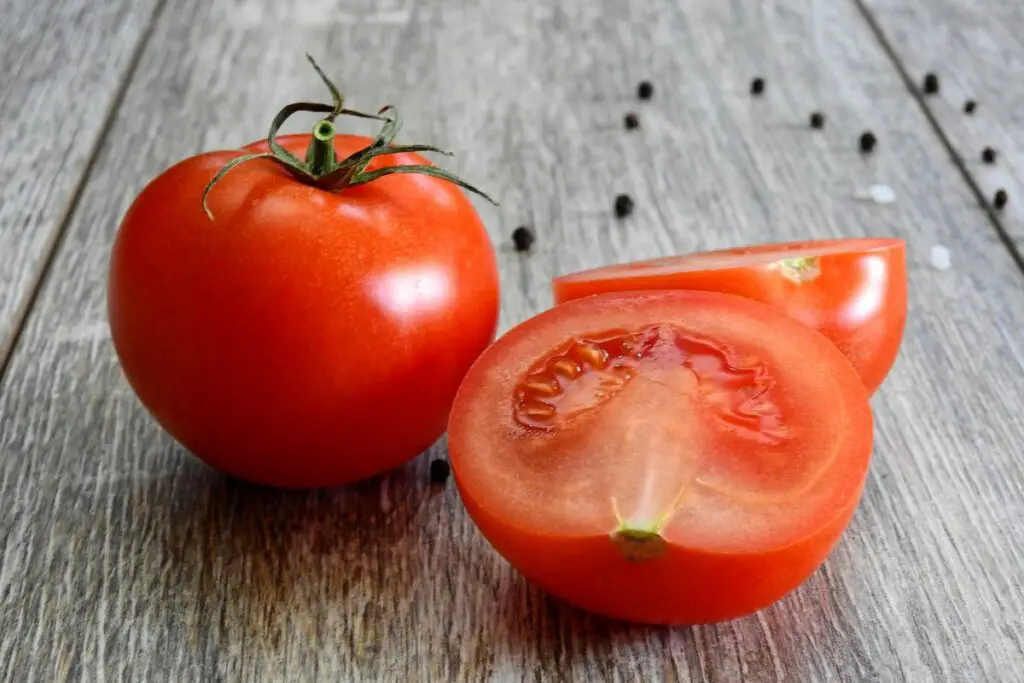
Can I Add Tomato To My Soap?
You can add tomato to your soap as a natural colorant. Tomato paste or tomato puree is often used to infuse soap with a vibrant orange color, making it visually appealing. Depending on tomatoes quality and the quantity you use, you can color your soap from light yellow to a dark orange.
It’s a great way to use overripe tomatoes, like those ones about to water explode if you try to slice them. Instead of spaghetti sauce, try to use them to make soap. Just don’t use them if they are spoiled, handmade soap requires quality ingredients to be good.
Tomato is also a natural ingredient. Unless you’re alergic to tomatoes, in which case you should avoid this ingredient in soap, tomato is as harmless as a dye as it gets.

Is Tomato Soap Good For The Skin?
Tomato soap is often marketed as beneficial for the skin due to the vitamins, antioxidants, and natural color it can provide. However, it’s crucial to manage your expectations when it comes to the actual skincare benefits it can offer.
Tomatoes are rich in vitamins A, C, and K, as well as lycopene, which is known for its antioxidant properties. These nutrients can be beneficial for the skin when applied topically. Vitamin A promotes skin health and helps repair damaged skin cells, while vitamin C brightens the complexion and stimulates collagen production. Lycopene has antioxidant properties that may protect the skin from free radical damage.
But it’s important to note that during the soapmaking process, many of the original properties of tomatoes are altered or diminished. The use of lye and high pH levels can alter the composition and potency of these beneficial compounds. As a result, the potential skincare benefits of tomatoes may be diminished in tomato soap.
Therefore, if you’re considering adding tomato to your soap for its potential skin benefits, it’s essential to manage your expectations. The soap-making process may not preserve all of the tomato’s original properties. To maximize potential benefits, consider using tomato-based skincare products in addition to tomato soap.
If you want to find out more about applying tomato in skincare, read this article from Healthline: Tomato Benefits For Skin.
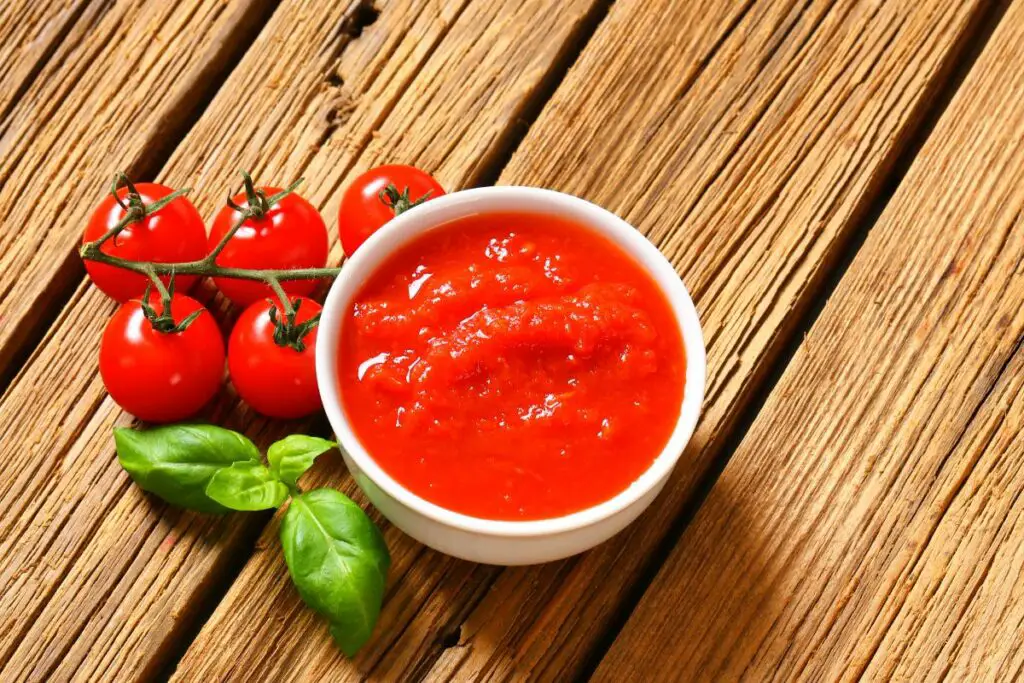
What Are The Key Ingredients For A Tomato Soap Recipe?
In this recipe, I’ve used a tomato puree I’ve made at home, and it’s the main ingredient for our tomato soap. You may buy pre-made tomato puree or paste, just be aware that it includes some food preservatives and it’s not so natural as a homemade tomato pureé.
Here is a recipe to make tomato paste, just know you can stop the recipe at 5min mark, as we don’t need a nice tomato paste. To add salt or not is irrelevant. We don’t need to condiment the tomato puree as we are not going to eat it, but the recipe does use salt as a soap hardener, so it’s not harmful to be there.
For the tomato soap, and to summarize, we just need our tomato cooked and uniformely blended in a puree. Whether you want to purchase it, make it from tomatoes you already have, or use some tomato paste you have already done for cooking, it’s up to you.
We will use this puree in full replacement of the lye water for our soap recipe. Make sure you use the puree completely cold (room temperature is enough).
This soap recipe will use one of the simplest oil mixtures you may find for soap: olive oil and coconut oil. Olive oil will probably borrow some of its yellow color to the soap, making the orange color from the tomato puree a bit stronger.
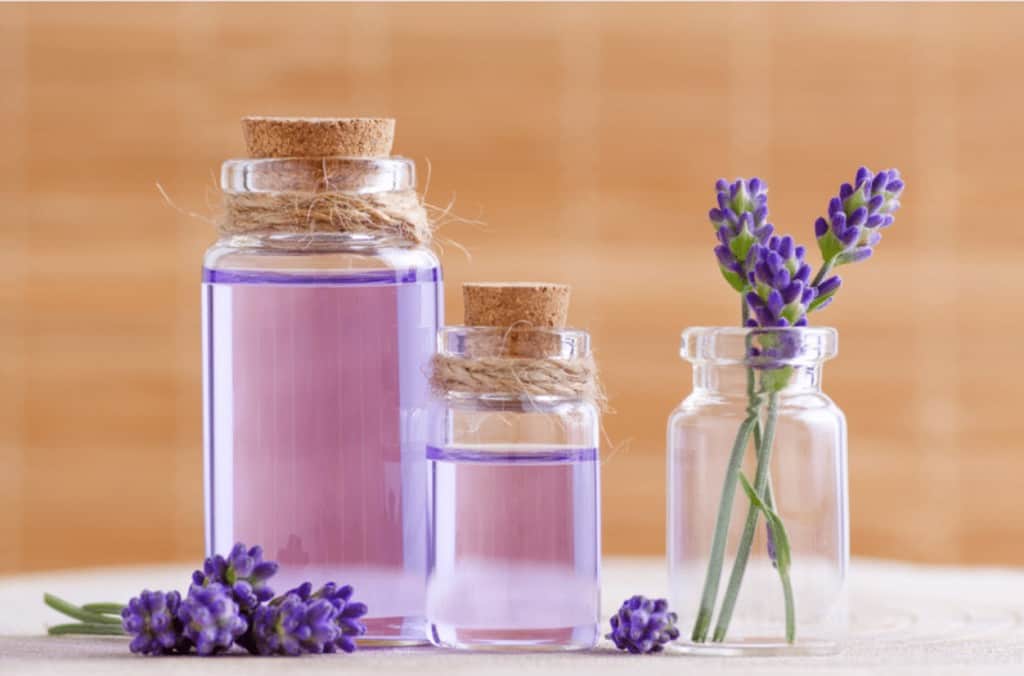
Finally, we need a scent for this soap! Getting a scent for a tomato soap is not easy. You want to to smell like soap or like fresh tomato? Being this basically an orange soap, you might want to go for a citrus scent (lemongrass, orange, …). There is a tomato leaf fragrance oil that has a weird scent, and might make some sense in this soap. If you like it, go for it (just be aware that fragrances might accelerate your soap).
In the end, I’ve used a woodsy mix of essencial oils – vetiver, sandal – with lavender and ylang-ylang. Well, I don’t know if it makes sense in a tomato soap, but the soap smells wonderful!
How Do You Make Homemade Tomato Soap?
As mentioned before, this recipe uses tomato puree as a natural colorant. It is going to be added in the lye water. For a strong color effect, I’ve actually replaced all the lye water as tomato puree. This is a bit of an unorthodox choice, and you will know why right in the next chapter.
You may also add tomato puree at light trace but stick only with one or two spoons and be warned that the color might be much lighter.
Making the Lye Water
Ok, this is probably the only reason why this recipe is not for beginners. When making lye water with a sugary liquid, you need to be aware that you are going to have a strong reaction, a volcano effect. It will be similar to using hot water with lye.
When we mix lye in water, we have an exothermic reaction (it releases heat). Sugar and higher temperature act as an “chemical accelerant” and the reaction becomes more violent. I know we are using a tomato puree, but most food and plants have sugar substances in their composition (even if they are not sweet).
So… Although it’s only for a few seconds, be ready for a volcano effect. This is why most soap recipes only use a couple of spoons of sugary liquids like this tomato puree in the lye water instead of a full replacement. However, I did want to go for a strong color, as natural ingredients tend to fade its color in cold process soap with time.
This is also why you MUST AVOID to use the tomato puree still hot or even warm. Use it only a room temperature or even a bit chilled. If the tomato puree is hot, this volcano effect will be even stronger!!
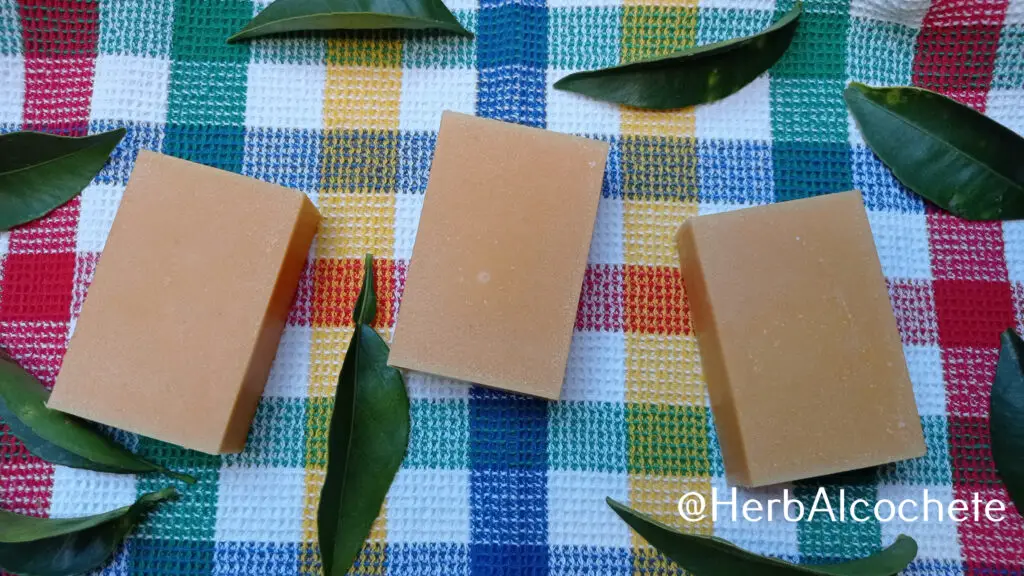
Making Tomato Soap
Apart from a special lye water, this tomato soap recipe is a simple cold process recipe. This soap was prepared to avoid soap acceleration: an oil mixture rich in olive oil, room temperature when you mix lye water with oils and low water discount (lye concentration of 25%).
All this because the lye water contains sugars, which can accelerate soap. If you are using a fragrance instead of the suggested essential oil blend, you might also get some soap acceleration and/or ricing. However, it’s unlikely.

Most likely, it will take a long time to reach medium trace. And you really don’t need to get that far. Once your soap is fully emulsified – no floating oils, homogeneous batter with a light color – just pour the soap in your molds. The rest of the saponification will happen there.
If this is your very first soap recipe, I suggest to start with one of the Beginner Soap Recipes and read first the tutorial Learn To Make Cold Process Soap. This is a simple cold process soap recipe, but the lye water requires some soapmaking experience.
Find Where To Buy Homemade Tomato Soap
Tomato soap souds fun and you want to try it, but you don’t feel ready to try this recipe at home? You can buy handmade tomato soaps in the following links:
How To Use This Soap
In the shower or bath, wet your hands and rub your soap in them to create a lather. Wash your hands first, then repeat the process and apply soap to your whole body using the soap directly and your hands. You may also wash your face with it. Rinse hands and body abundantly. Also wash your soap from lather before placing it in your soap dish or bag saver.
Washcloths and sponges should be avoided. Avoid washing your intimate zone and your hair, soap pH in not adequate for those parts of your body. Avoid eye contact with soap to prevent stinging. Make a patch test before using your soap. Stop using your soap if you feel any immediate adverse reaction in your skin (red skin, rashes, itching).
To take best advantage of your handmade soap (made by yourself or store-bougth), read How Do You Use Handmade Soap?
Related Posts
Ingredients and Recipes
- Vegetable oils: Oil Properties For Soap Making
- Essential oils: Best Essential Oils for Soap Making
- Colorants: How To Color Your Soap With Kitchen Ingredients
- Beginner Recipes: Soap Recipes for Beginners
- Cold Process Soap Recipes: Free Cold Process Soap Recipes
Soap Making Techniques and Troubleshooting
- Cold Process Tutorial Guide: Learn To Make Cold Process Soap?
- Soap Making Methods: How To Make Soap At Home
- Soap Making Trace: Know Everything About Trace in Soap Making
- Soap Acceleration: Causes, How To Avoid It Or How To Fix It
- Soda Ash In Soap: What It Is, How to Remove It
Watch This Video About Safety
Cold Process Soap Making Tutorial Video
Cold Process Soap Making Lessons
The tutorials in this blog are a great – and free! – help to start with cold process soap making. Practice is the next step to harness the art of making soaps at home. However, I understand if you prefer to have some formal lessons, where you will feel more supported with the steps. Feel free to join these courses at Udemy.
Equipment
Ingredients
Lye Water
- 189 g tomato puree distilled water with 2 tbsp of tomato puree
- 69 g lye (100% sodium hydroxide)
- 10 g citric acid
- 1 tsp fine sea salt
Oils/Fat
After Trace Ingredients
- 6 drops grapefruit seed extract (GSE) (anti-oxidant) or rosemary oleorresin extract
- 13 ml essential oils blend tomato leaf fragrance oil
Essential Oil Blend
Instructions
Get Ready!
- Wear goggles and gloves! Look at “Safety Precautions” in the video above or in Soap Making Safety Precautions
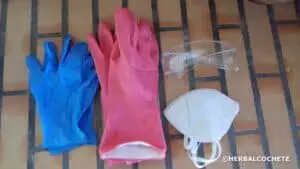
- Watch the video above about "Cold Process Soap Making Tutorial" or read the post Learn To Make Cold Process Soap for instructions on cold process soap making before starting. These are generic but important steps for all recipes.

- Prepare the tomato puree in advance: check Google for recipes on how to do it, there are several ways. I have simply cooked some tomatoes, and blended them into a puree. 3 tomatoes should be enough to make around 200 ml/6.76 fl oz of tomato puree. If you don't have enough for the lye water, add water.
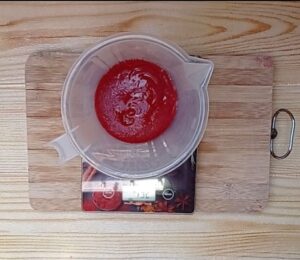
- Assemble everything: ingredients, equipment, safety equipment. Prepare your workstations. Measure all the ingredients. Don’t start the recipe without having everything ready!
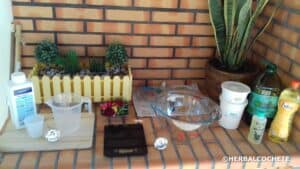
Heat the Oils
- Heat all your oils in a pyrex bowl at the microwave until the coconut oil melts. Use 1 min periods and check temperature. The oils shouldn't overheat (> 60 °C)

Make the Lye Water
- Make the lye solution according to How To Make Lye Water, using the tomato puree instead of distilled water. Add the citric acid before the lye. Mix it well until the vapors start to dissipate.189 g tomato puree, 69 g lye (100% sodium hydroxide)
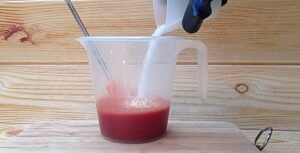
- ATTENTION: beware that you will have a volcano effect due to the sugary content of tomato puree!! Be fully equipped with your safety equipment, make sure your area is prepared for some lye water spillage – place some paper towels below your pitcher.
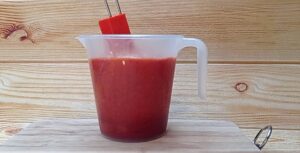
Make the Soap Batter
- Use as target temperature 25 °C for the oil-solution mixture, or as low as you can while keeping the coconut oil fully liquid. The lye and oils should not have a difference of more than 10ºC/ºF between them.
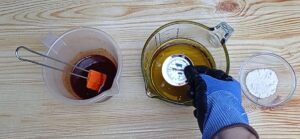
- Pour the lye water into the oils carefully, using a spatula or the edge of the bowl

- Mix oils and lye with the immersion blender.
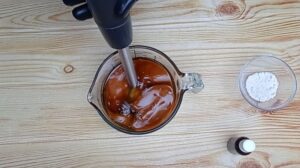
- Add the oat powder in the meantime.
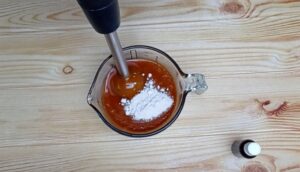
- Reach trace with the immersion blender. With a high olive oil content and low temperatures, this soap batter might take some time before reaching medium trace. As long as the soap is fully emulsified – no floating oils -, looking like in the picture, you don't need to reach medium trace.
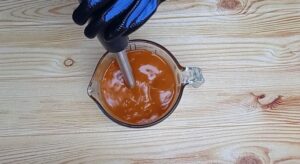
Add After Trace Ingredients
- Add the extract and the essential oil blend. Mix with a spoon or spatula. In this special case, you might do it with the immersoin blender as well.6 drops grapefruit seed extract (GSE) (anti-oxidant), 13 ml essential oils blend
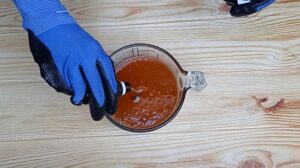
Molding and Curing
- Pour the soap in individual soap molds and sprinkle with alcohol or witch hazel.

- Let it set for 48 hours.
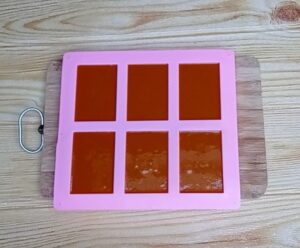
- Learn how to clean all equipment with How to Clean Soap Making Equipment.
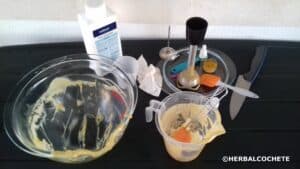
Curing the Soap Bars
- Unmold the soaps after 48 hours and let the bars cure for 4 to 6 weeks in a ventilated place. See How To Cure Soap and How Do You Store Homemade Soap?
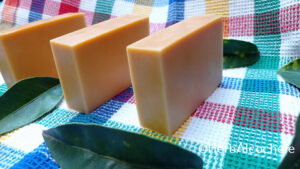
- Enjoy your soaps!!
